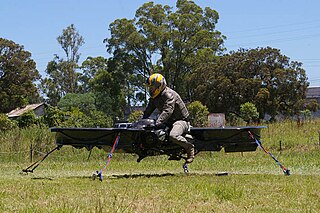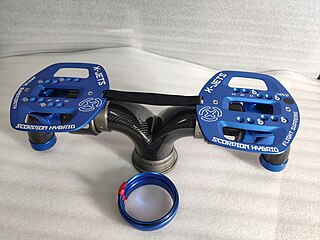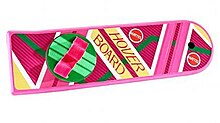
A hovercraft, also known as an air-cushion vehicle or ACV, is an amphibious craft capable of travelling over land, water, mud, ice, and various other surfaces.

Back to the Future Part II is a 1989 American science fiction film directed by Robert Zemeckis from a screenplay by Bob Gale; both wrote the story. It is the sequel to the 1985 film Back to the Future and the second installment in the Back to the Future franchise. The film stars Michael J. Fox, Christopher Lloyd, Lea Thompson, and Thomas F. Wilson with Elisabeth Shue, and Jeffrey Weissman in supporting roles. It follows Marty McFly (Fox) and his friend Dr. Emmett "Doc" Brown (Lloyd) as they travel from 1985 to 2015 to prevent Marty's son from sabotaging the McFly family's future. When their arch-nemesis Biff Tannen (Wilson) steals Doc's DeLorean time machine and uses it to alter history for his benefit, the duo must return to 1955 to restore the timeline.

A jet pack, rocket belt, rocket pack or flight pack is a device worn as a backpack which uses jets to propel the wearer through the air. The concept has been present in science fiction for almost a century and the first working experimental devices were demonstrated in the 1960s.

Maglev is a system of rail transport whose rolling stock is levitated by electromagnets rather than rolled on wheels, eliminating rolling resistance.

A hover car is a personal vehicle that flies at a constant altitude of up to a few meters (yards) above the ground and used for personal transportation in the same way a modern automobile is employed. The concept usually appears in science fiction.

In the Back to the Future franchise, the DeLorean time machine is a time travel vehicle constructed from a retrofitted DMC DeLorean. Its time travel ability is derived from the "flux capacitor", a component that allows the car to travel to the past or future. This occurs when the car accelerates to 88 miles per hour and requires 1.21 gigawatts of electricity.

Holy Trinity Academy (HTA), also referred to as the Most Holy Trinity Academy, or colloquially as Holy, is a private parochial co-educational school in Sampaloc, Manila, Philippines. The school was established in June 1947 by Rev. Fr. Bernardo Torres. The school accepted both male and female students, but in separate departments, until it became fully co-educational in 1976.

A hoverbike is a vehicle that can hover, resembling a flying motorbike, having at least two propulsive portions—one in front of and one behind the driver. It is often used as a staple vehicle in science fiction and near future settings, but since the early 2010s some attempts have been made at developing a functional, practical hoverbike.

A Flyboard is a brand of hydroflighting device which supplies propulsion to drive the Flyboard into the air to perform a sport known as hydroflying.
The Slide is a magnetically levatating hoverboard demonstration developed by Lexus, who built a skate park in Barcelona, Spain specifically for the project. The system was built as a promotional demonstration and was not on sale to the public.

A self-balancing scooter is a self-balancing personal transporter consisting of two motorized wheels connected to a pair of articulated pads on which the rider places their feet. The rider controls the speed by leaning forward or backward, and direction of travel by twisting the pads.

Shane Chen is a Chinese-American inventor and entrepreneur based in Camas, WA USA. He is best known for inventing the self-balancing hoverboard.

Hydroflight sports are a category of sport in which water jet propulsion is used to create sustained flight where lift and movement are controlled by a person riding on a propulsion device. Competitions for this sport started around 2012. There are many training centres throughout the world where beginners go to learn and practice skills so they can fly these devices by themselves.
Flyboard Air is a type of jetpack/hoverboard powered by gas turbines. It was invented by French water-craft rider Franky Zapata, founder of Zapata racing.

The JetLev is a water-propelled jet pack powered through a floater derived from jetski technology attached through an umbilical to the backpack which contains two nozzles and two control arms, in a configuration like traditional rocket belts and gas turbine jet belts. The JetLev also functions underwater, allowing users to dive into the water and jet back out. The jetpack can allow users to fly up to 10 m above the water. It was created by Chinese Canadian, Raymond Li. JetLev became the first practical amateur-usable jet pack, and first with practical usable duration. The JetLev technology jetpack became the first commercially released jetpack in 2009. It was initially offered for sale for US$100,000, however with much cheaper competitors coming on the market afterwards, inspired by the original JetLev, such as the Flyboard, prices rapidly dropped, with cheaper models.

The Daedalus Flight Pack is a jet suit capable of flying, hovering and powered jumps. It was created by British inventor Richard Browning, an athlete and Royal Marine Reservist. The Daedalus is different from other manned portable flight packs in that it uses additional jets attached to the hands. These enable it to be directed by moving the arms.

A personal transporter is any of a class of compact, mostly recent, motorised micromobility vehicle for transporting an individual at speeds that do not normally exceed 25 km/h (16 mph). They include electric skateboards, kick scooters, self-balancing unicycles and Segways, as well as gasoline-fueled motorised scooters or skateboards, typically using two-stroke engines of less than 49 cc (3.0 cu in) displacement. Many newer versions use recent advances in vehicle battery and motor-control technologies. They are growing in popularity, and legislators are in the process of determining how these devices should be classified, regulated and accommodated during a period of rapid innovation.

Franky Zapata is a French personal watercraft pilot who is the inventor of the Flyboard and Flyboard Air, and founder of Zapata Racing. Since 2012, Zapata's efforts have been focused on the development and manufacture of personal flyers for land and aquatic applications.
















